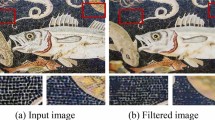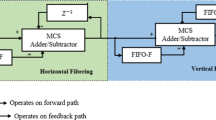Abstract
In order to speed up the bilateral filtering algorithm, a fast bilateral filtering algorithm based on raised cosine with compressibility factor (BRCF) is proposed. The BRCF uses a raised cosine function with a compression coefficient to replace Gaussian function as the range kernel function, and uses a limited number of linear convolution calculations to achieve bilateral filtering. Then, the improved BRCF (IBRCF) with a compression factor is proposed to accelerate the convergence rate of the raised cosine function. Compared to the published raised cosine algorithm, Taylor polynomial algorithm, and Gaussian polynomial algorithm, the computer simulation results show that the proposed IBRCF has a faster convergence rate with almost the same peak signal-to-noise ratio. After filtered seven images by various algorithms, the running time of the new IBRCF algorithm was confirmed to be less than 1/5 of Gaussian polynomial algorithm, while Gaussian polynomial algorithm was faster than the published raised cosine algorithm and Taylor polynomial algorithm. The mathematical proofs and algorithm flowcharts of the IBRCF algorithm are described in this paper in detail.





Similar content being viewed by others
Abbreviations
- BRCF:
-
Algorithm based on raised cosine with compressibility factor
- IBRCF:
-
The improved BRCF
- BF:
-
The bilateral filter
- TP:
-
Taylor polynomial
- BC:
-
The basic raised cosine
- GP:
-
Gaussian polynomial
- RRCPSNR:
-
The relative rate of change in PSNR
References
Tomasi C, Manduchi R (1998) Bilateral filtering for gray and color images. In: IEEE international conference on computer vision, pp 839–846
Biradar N, Dewal ML, Rohit MK, Jindal I (2016) Echocardiographic image denoising using extreme total variation bilateral filter. Opt Int J Light Electron Opt 127(1):30–38
Zhang M, Gunturk BK (2008) Multiresolution bilateral filtering for image denoising. IEEE Trans Image Process 17(12):2324–2333
Liu N, Chen X (2006) Infrared image detail enhancement approach based on improved joint bilateral filter. Infrared Phys Technol 77:405–413
Bae S, Paris S (2006) Two-scale tone management for photographic look. ACM Trans Graph 25:637–645
Tripathi A.K, Mukhopadhyay S (2012) Single image fog removal using bilateral filter. In: IEEE international conference on signal processing, computing and control, pp 1–6
Zhang M, Gunturk B.K (2009) Compression artifact reduction with adaptive bilateral filtering. In: Visual communications and image processing. International Society for Optics and Photonics, pp 499–504
Shao HC, Hwang WL (2016) Light field upsampling by joint bilateral filtering on epipolar plane images. In: Asia-Pacific signal and information processing association annual summit and conference, pp 1–5
Gunturk BK (2011) Fast bilateral filter with arbitrary range and domain kernels. IEEE Trans Image Process 20(9):2690–2696
Al-Ismaeil K, Aouada D, Ottersten B (2012) Bilateral filter evaluation based on exponential kernels. In: IEEE international conference on pattern recognition, pp 258–261
Yang Q (2014) Hardware-efficient bilateral filtering for stereo matching. IEEE Trans Pattern Anal Mach Intell 36(5):1026–1032
Porikli F (2008) Constant time O(1) bilateral filtering. In: IEEE conference on computer vision and pattern recognition, pp 1–8
Yang Q, Tan KH, Ahuja N (2009) Real-time O(1) bilateral filtering. In: IEEE conference on computer vision and pattern recognition, pp 557–564
Paris S, Durand F (2009) A fast approximation of the bilateral filter using a signal processing approach. Int J Comput Vis 81(1):24–52
Sugimoto K, Kamata S (2015) Compressive bilateral filtering. IEEE Trans Image Process 24(11):3357–3369
Chaudhury KN (2011) Constant-time filtering using shiftable kernels. IEEE Signal Process Lett 18(11):651–654
Chaudhury KN, Sage D, Unser M (2011) Fast O(1) bilateral filtering using trigonometric range kernels. IEEE Trans Image Process 20(12):3376–3382
Chaudhury KN (2013) Acceleration of the shiftable O(1) algorithm for bilateral filtering and nonlocal means. IEEE Trans Image Process 22(4):1291–1300
Chaudhury KN, Dabhade SD (2016) Fast and provably accurate bilateral filtering. IEEE Trans Image Process 25(6):2519–2528
Yang Q, Ahuja N, Tan KH (2015) Constant time median and bilateral filtering. Int J Comput Vis 112(3):307–318
Muhammad N, Bibi N, Jahangir A et al (2018) Image denoising with norm weighted fusion estimators. Pattern Anal Appl 21(4):1013–1022
Muhammad N, Bibi N, Wahab A et al (2018) Image de-noising with subband replacement and fusion process using Bayes estimators. Comput Electr Eng 70:413–427
Muhammad N, Bibi N, Qasim I et al (2018) Digital watermarking using Hall property image decomposition method. Pattern Anal Appl 21(4):997–1012
Muhammad N, Bibi N (2015) Digital image watermarking using partial pivoting lower and upper triangular decomposition into the wavelet domain. IET Image Proc 9(9):795–803
Yao L, Wu Y, Li M et al (2018) Design of three-dimensional filtering balun with inherent complete ground and enhanced stopband rejection. Electron Lett 54(6):361–362
Author information
Authors and Affiliations
Contributions
We propose a fast bilateral filtering algorithm based on raised cosine with compressibility factor (BRCF) and propose an improved BRCF with a compression factor to accelerate the convergence rate of the raised cosine function. Meanwhile, we present a rigorous performance analysis for these algorithms. All authors read and approved the final manuscript.
Corresponding author
Ethics declarations
Conflict of interest
The authors declare that they have no conflict of interest.
Additional information
Publisher's Note
Springer Nature remains neutral with regard to jurisdictional claims in published maps and institutional affiliations.
Appendix
Appendix
Proposition 3.1
The IBRCF fast algorithm can be expressed as
where
Proof
Equation (23) can be converted to the following equation,
It can be shown that \(w_{\lambda ,N,M} (x)\) is the sum of linear combinations of raised cosine functions. Substituting Eq. (a) into Eq. (1), the IBRCF algorithm can be expressed as
where
Furthermore, according to Eq. (13), we can write
Substituting Eq. (d) into Eq. (c) yields Eq. (25). Similarly, Eq. (26) can be obtained by using the same calculation procedure.
Rights and permissions
About this article
Cite this article
Guo, J., Chen, C., Xiang, S. et al. A fast bilateral filtering algorithm based on rising cosine function. Neural Comput & Applic 31, 5097–5108 (2019). https://doi.org/10.1007/s00521-018-04001-y
Received:
Accepted:
Published:
Issue Date:
DOI: https://doi.org/10.1007/s00521-018-04001-y




